When it comes to planning a trip to Europe, two cities that often come to mind are between Berlin vs Amsterdam. Both cities are known for their unique charm, vibrant culture, and a wide range of tourist attractions.
But how do they compare? In this article, I will take you on a journey through these two European gems, highlighting their cultural differences, sharing valuable travel tips, and helping you decide which city is the best to visit for your next adventure.

Table of Contents
Key Takeaways:
- Berlin and Amsterdam are both fascinating cities with their own distinct characteristics.
- When comparing these cities, consider factors such as cost of living, transportation, climate, healthcare, and cultural experiences.
- Berlin offers a rich history, vibrant art scene, and diverse cultural experiences.
- Amsterdam charms with its picturesque canals, renowned museums, and lively atmosphere.
- The choice between Berlin and Amsterdam ultimately depends on your personal preferences and interests.
Berlin vs Amsterdam
City Profile of Berlin
Berlin is a fascinating city with a rich cultural heritage and a diverse population. Let’s take a closer look at some key aspects of Berlin’s city profile.
Geography and Size
Berlin is the capital and largest city of Germany. It is located in the northeastern part of the country and covers an area of approximately 891.85 square kilometers. The city is situated on the banks of the River Spree, with numerous canals and lakes throughout its urban landscape.
Population and Diversity
Berlin has a population of approximately 3.7 million people, making it one of the most populous cities in Europe. The city is known for its cultural diversity, with residents from various ethnic and national backgrounds. This diversity is reflected in the vibrant neighborhoods, international cuisine, and multicultural events that take place in Berlin.
Landmarks and Attractions
Berlin is home to many famous landmarks and attractions that reflect its historical significance and cultural heritage. Some of the must-visit sights include the iconic Brandenburg Gate, the Berlin Wall Memorial, and the Reichstag building. Visitors can also explore world-class museums, such as the Pergamon Museum and the Museum Island.
| Aspect | Details |
|---|---|
| Geography | Located in northeastern Germany, on the banks of the River Spree |
| Size | 891.85 square kilometers |
| Population | Approximately 3.7 million people |
| Diversity | Culturally diverse with residents from various ethnic and national backgrounds |
As you can see, Berlin is a vibrant and multicultural city with a rich history. Its unique mix of historical landmarks, diverse neighborhoods, and thriving cultural scene make it a captivating destination to explore.
City Profile of Amsterdam
Amsterdam is a charming city in the Netherlands, known for its picturesque canals, historic architecture, and vibrant cultural scene. With a population of 872,680 people and covering an area of 165 square kilometers, Amsterdam is a relatively small and compact city.
It offers a unique blend of old-world charm and modern cosmopolitanism, making it a popular destination for tourists from around the world.
One of the defining characteristics of Amsterdam is its diversity. The city is home to people from various cultural backgrounds, creating a multicultural and inclusive atmosphere.
Visitors can experience a wide range of cuisines, languages, and traditions, making Amsterdam a truly global city. This diversity is reflected in the numerous cultural events, festivals, and exhibitions that take place throughout the year.
When it comes to the size and layout of Amsterdam, the city’s geography is defined by its iconic canals. The Canal Ring, a UNESCO World Heritage site, is a network of concentric canals that form the heart of the city.
These canals, along with the historic buildings that line them, contribute to Amsterdam’s unique and romantic atmosphere. The city is also known for its numerous parks and green spaces, providing residents and visitors alike with opportunities for relaxation and outdoor activities.
Overall, Amsterdam’s city profile showcases a vibrant and diverse city that combines history, culture, and natural beauty.
Whether it’s exploring the canal-lined streets, visiting world-class museums like the Rijksmuseum and the Van Gogh Museum, or simply soaking up the atmosphere in cozy cafes, Amsterdam offers a unique and memorable experience for travelers.
| Population | Diversity | Geography |
|---|---|---|
| 872,680 people | Multicultural and inclusive | Canals, historic buildings, and green spaces |

“Amsterdam is a vibrant and diverse city, known for its picturesque canals, multicultural atmosphere, and historic architecture.”
History of Berlin and Amsterdam
When exploring the fascinating cities of Berlin and Amsterdam, it is impossible to overlook their rich histories and iconic landmarks. Both cities have been shaped by significant events and eras that have left a lasting impact on their cultures and identities.
Berlin: A City of Resilience and Remembrance
Berlin’s history is marked by resilience and transformation. From the devastation of World War II to the division of the city by the Berlin Wall, Berlin has emerged as a symbol of hope, unity, and creative revival.
The scars of the past can still be seen today, with historic sites such as the Berlin Wall Memorial and Checkpoint Charlie serving as reminders of the city’s tumultuous history.
Alongside these reminders of division, Berlin also celebrates its cultural heritage through its world-renowned landmarks. The Brandenburg Gate, a symbol of unity, stands proudly in the heart of the city.
The Reichstag building, with its iconic glass dome, represents the city’s journey towards democracy. The Museum Island, a UNESCO World Heritage site, houses a collection of remarkable museums showcasing art, history, and culture.
Amsterdam: A Tale of Prosperity and Artistic Brilliance
Amsterdam’s history is characterized by a period of prosperity known as the Dutch Golden Age. During this time, the city experienced significant economic growth, establishing itself as a center of trade, art, and innovation.
The legacy of this era can be seen in Amsterdam’s beautifully preserved historic buildings and canals, which have earned the city its UNESCO World Heritage status.
Amsterdam is also known for its rich artistic heritage. The city was home to renowned painters such as Rembrandt and Vermeer, who contributed to the Dutch Golden Age art movement. Today, the Rijksmuseum and the Van Gogh Museum attract art enthusiasts from around the world, showcasing the works of Dutch masters.
| Berlin | Amsterdam | |
|---|---|---|
| Key Historical Events | World War II, division by the Berlin Wall | Dutch Golden Age, economic prosperity |
| Iconic Landmarks | Brandenburg Gate, Berlin Wall Memorial, Museum Island | Rijksmuseum, Van Gogh Museum, historic canals |
| Historical Significance | Symbol of resilience, unity, and cultural revival | Legacy of prosperity and artistic brilliance |
As visitors explore Berlin and Amsterdam, they will encounter a captivating blend of history, culture, and artistic expression. These cities not only boast remarkable landmarks but also offer a glimpse into the stories and events that have shaped their identities. From Berlin’s resilience to Amsterdam’s prosperity, the history of these cities adds depth and character to the vibrant experiences they have to offer.

Cost of Living in Berlin
Living in Berlin offers a relatively affordable cost of living compared to other major European cities. However, it’s important to consider the costs of housing, food, transportation, and other expenses when planning your budget.
Housing: The cost of housing in Berlin has been increasing in recent years due to high demand. Rent prices vary depending on the neighborhood and the size of the apartment. On average, a one-bedroom apartment in the city center can cost around €1,200 to €1,500 per month, while in the outskirts, the prices can range from €800 to €1,200 per month.
Food: When it comes to food prices, Berlin offers a wide range of options to fit different budgets. Eating out at restaurants or cafes can cost between €10 to €20 for a meal. If you prefer cooking at home, groceries can be affordable, with basic items like bread, milk, and vegetables priced reasonably.
Transportation: Berlin has an efficient and affordable public transportation system, which includes buses, trams, and the metro. A single ticket for a one-way trip costs €2.80, but it’s more cost-effective to get a daily or monthly pass if you’re using public transport frequently. Additionally, the city has a well-established biking culture, and renting a bike can be an economical and eco-friendly way to get around.
| Expense | Average Cost |
|---|---|
| Housing | €800 – €1,500 per month |
| Food | €10 – €20 per meal |
| Transportation | €2.80 per single trip |
It’s also worth noting that the minimum wage in Berlin is relatively high compared to other German cities and countries in Europe. As of 2021, the minimum wage in Germany is €9.60 per hour. This ensures that workers in Berlin have a decent standard of living and can cover their basic expenses.
Overall, while the cost of living in Berlin has been increasing, it still remains relatively affordable compared to other major European cities. By budgeting wisely and taking advantage of the city’s affordable transportation options and diverse food scene, you can make the most of your time in Berlin without breaking the bank.
Cost of Living in Amsterdam
When considering the cost of living in Amsterdam, it’s important to note that the city is known for having a higher cost of living compared to other European cities. One of the major contributors to this higher cost is housing.
The demand for housing in Amsterdam is high, and as a result, rental prices can be quite steep. It’s not uncommon for renters to pay a significant portion of their income on housing expenses.
In addition to housing, food prices in Amsterdam can also be higher compared to other cities. Eating out at restaurants or cafes can be quite expensive, especially in popular tourist areas.
However, there are also affordable options available, such as local markets and grocery stores, where you can find fresh produce and ingredients at more reasonable prices.
When it comes to transportation costs, Amsterdam offers an efficient and comprehensive public transportation system, which includes trams, buses, and metros.
The cost of monthly public transportation passes is relatively affordable and can provide unlimited access to the city’s transportation network. Additionally, Amsterdam is known for its bike culture, and cycling is a popular and cost-effective way to get around the city.
Table: Cost of Living Comparison – Amsterdam vs Berlin
| Amsterdam | Berlin | |
|---|---|---|
| Housing | High | Lower |
| Food Prices | Higher | Affordable |
| Transportation Costs | Affordable | Affordable |
| Minimum Wage | Relatively high | Relatively high |
“Living in Amsterdam can be more expensive than in other cities, but it also offers a high quality of life and a range of opportunities. It’s important to carefully consider your budget and prioritize your expenses when planning to live in the city.”
In conclusion, while Amsterdam may have a higher cost of living compared to other cities, it also offers a high standard of living and a range of cultural experiences. By carefully managing expenses and taking advantage of affordable transportation options and local markets, it’s possible to enjoy the city without breaking the bank. Ultimately, the decision to live in Amsterdam should be based on personal preferences and priorities.
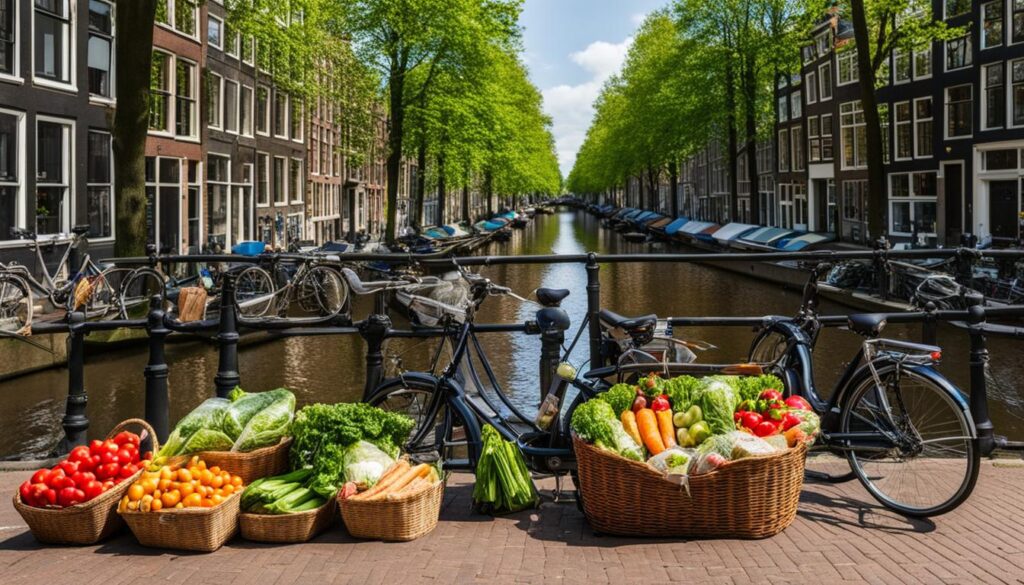
Transportation in Berlin
When it comes to transportation, Berlin offers a well-developed public transportation system that makes getting around the city convenient and efficient.
The public transportation network includes buses, trams, and the metro, providing extensive coverage throughout the city. Whether you’re visiting tourist attractions or exploring local neighborhoods, public transportation in Berlin is a reliable option.
One of the highlights of Berlin’s transportation system is its extensive metro network, known as the U-Bahn. With its iconic yellow trains, the U-Bahn connects various parts of the city and is a popular choice for both locals and tourists.
The U-Bahn operates from early morning until late at night, making it accessible for commuters and night owls alike. The metro lines are easy to navigate, with clear signage and announcements in multiple languages.
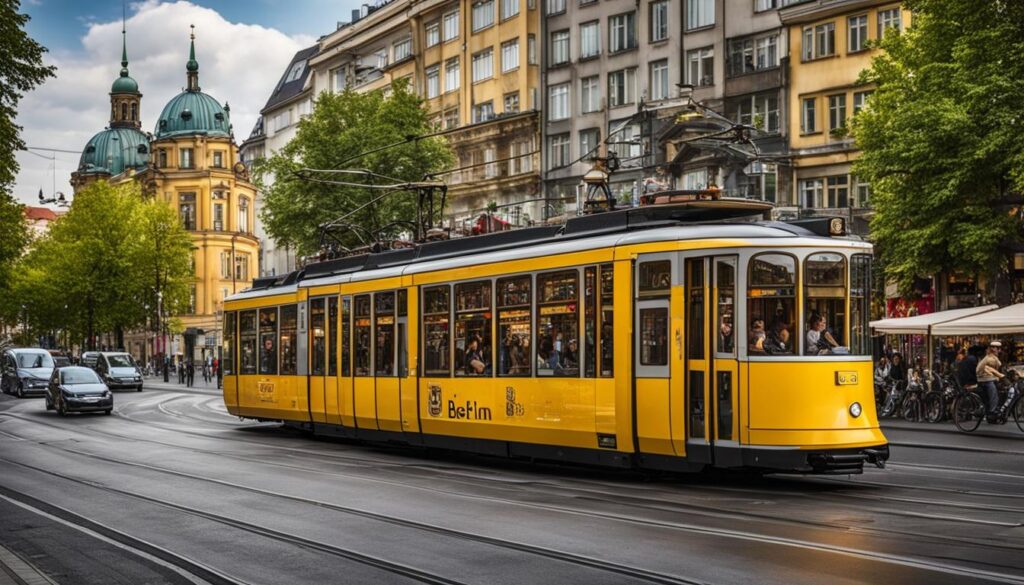
Berlin is also known for its bike-friendly culture, which provides an alternative mode of transportation for those who prefer cycling. The city has an extensive network of bike lanes, making it easy and safe to explore Berlin on two wheels.
You can rent a bike from various bike-sharing services scattered throughout the city and enjoy a leisurely ride along the picturesque streets and parks.
For travelers arriving in Berlin by air, the city has two major airports: Tegel and Schönefeld. Tegel is the main international airport, while Schönefeld primarily serves low-cost airlines. Both airports are well-connected to the city center by public transportation, offering convenient options for arriving and departing passengers.
Public Transportation Options in Berlin
Here’s a summary of the public transportation options available in Berlin:
| Transportation Mode | Description |
|---|---|
| U-Bahn (Metro) | A comprehensive metro network with multiple lines, connecting various parts of the city. |
| Buses | An extensive bus network covering all neighborhoods and suburbs of Berlin. |
| Trams | Tram lines providing transportation within the city, particularly in the eastern part of Berlin. |
| Bikes | A bike-friendly city with bike lanes and bike-sharing services available for a cycling experience. |
“Berlin’s public transportation system is reliable and efficient, allowing visitors to explore the city easily and conveniently.”
Whether you choose to navigate Berlin by metro, bus, tram, or bike, you’ll find that the city’s transportation system is well-suited to accommodate your travel needs. With its extensive network and user-friendly infrastructure, getting around Berlin is a breeze.
Transportation in Amsterdam
When it comes to transportation, Amsterdam offers a comprehensive and efficient network to navigate the city. The public transportation system in Amsterdam includes trams, buses, and metros, providing convenient options for getting around. Whether you’re a tourist exploring the city or a local commuting to work, public transportation is a popular choice in Amsterdam.
The Amsterdam Tram system is one of the most iconic modes of transport in the city. With over 15 tram lines covering various parts of Amsterdam, it’s a convenient and reliable way to travel. The trams are known for their distinctive appearance, often painted in vibrant colors, and they offer a scenic view of the city as you travel.
Amsterdam is also well-served by Amsterdam Airport Schiphol, which is one of the busiest airports in Europe. Located just outside the city, it provides excellent connectivity to major international destinations. Whether you’re arriving or departing, the airport offers various transportation options to and from the city center, including trains and buses.
Biking Culture
One of the unique aspects of transportation in Amsterdam is its biking culture. The city is famous for its extensive network of bike paths and bike-friendly infrastructure, making cycling a popular mode of transportation. With its flat landscape and compact size, biking in Amsterdam offers a convenient and enjoyable way to explore the city.
Amsterdam’s bike culture is deeply ingrained in the lifestyle of its residents. It’s not uncommon to see locals of all ages cycling around the city for daily commutes, grocery shopping, or simply enjoying a leisurely ride along the canals. Many tourists also rent bikes to experience Amsterdam like a local and discover its hidden gems.
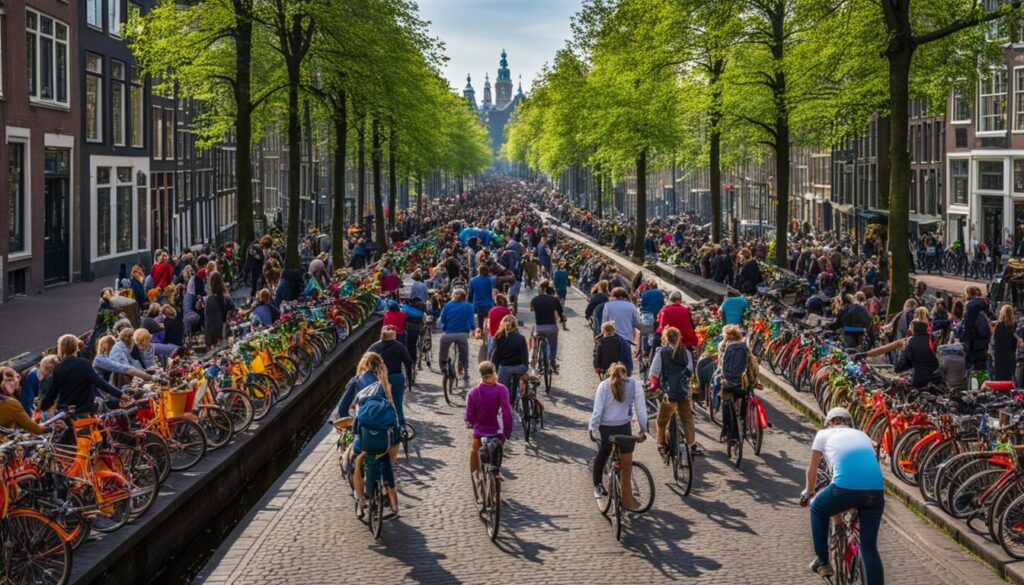
Overall, Amsterdam’s transportation system, including its trams, buses, and biking culture, provides accessible and efficient options for residents and visitors alike.
With its well-connected public transportation network and bike-friendly infrastructure, getting around Amsterdam is convenient, eco-friendly, and offers a unique way to experience the charm and beauty of the city.
Climate and Weather in Berlin
Berlin has a temperate seasonal climate, with mild summers and cold winters. The city experiences rainfall throughout the year, but the average annual rainfall is moderate. Summers can be warm, with occasional heatwaves, while winters can be cold with temperatures often dropping below freezing.
Seasonal Overview:
Spring (March to May): Spring in Berlin is typically mild, with temperatures ranging from 10 to 20°C (50 to 68°F). It is a great time to visit as the city comes alive with blossoming trees and flowers.
Summer (June to August): Summers in Berlin are warm, with temperatures ranging from 20 to 30°C (68 to 86°F). However, heatwaves can occur, resulting in temperatures above 30°C (86°F). It is the peak tourist season in Berlin, with longer days and plenty of outdoor festivals and events.
Fall (September to November): Fall in Berlin brings cooler temperatures ranging from 10 to 20°C (50 to 68°F). The city is adorned with beautiful autumn foliage, creating a picturesque atmosphere.
Winter (December to February): Winters in Berlin are cold, with temperatures often dropping below freezing. Snowfall is common, and temperatures range from -1 to 5°C (30 to 41°F). It is a magical time to visit, with Christmas markets and festive celebrations throughout the city.
Monthly Averages:
| Month | Average High Temperature (°C) | Average Low Temperature (°C) | Average Rainfall (mm) |
|---|---|---|---|
| January | 3 | -2 | 37 |
| February | 5 | -2 | 29 |
| March | 9 | 1 | 32 |
| April | 14 | 5 | 38 |
| May | 19 | 9 | 48 |
| June | 23 | 13 | 58 |
| July | 25 | 15 | 59 |
| August | 25 | 15 | 59 |
| September | 20 | 11 | 44 |
| October | 14 | 6 | 41 |
| November | 8 | 2 | 45 |
| December | 4 | -1 | 44 |
As seen in the table above, the rainfall in Berlin remains relatively consistent throughout the year, with slightly higher amounts in the summer months. It’s important to pack appropriate clothing and umbrella when visiting to be prepared for the changing weather conditions.
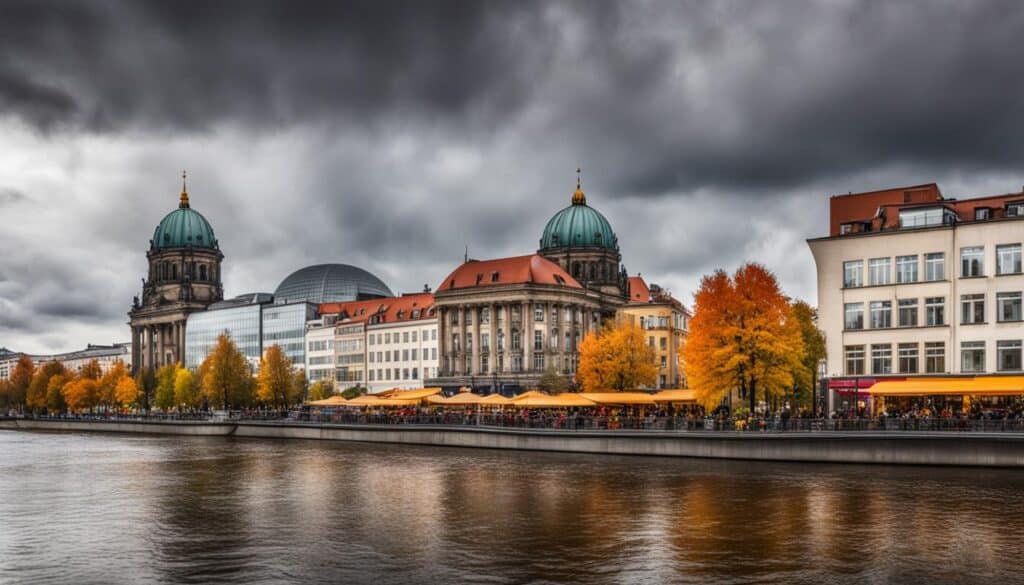
Climate and Weather in Amsterdam
When planning a trip to Amsterdam, it’s important to consider the city’s climate and weather conditions. The climate of Amsterdam is classified as maritime, with mild summers and cool winters. The city experiences rainfall throughout the year, with the highest amount of rainfall occurring in the summer months.
During the summer, temperatures in Amsterdam generally range from 17°C to 20°C (63°F to 68°F), making it a pleasant time to explore the city’s outdoor attractions and enjoy activities like cycling along the canals. However, it’s always a good idea to carry an umbrella or rain jacket, as sudden showers are not uncommon.
As autumn approaches, temperatures start to cool down, with average highs ranging from 14°C to 17°C (57°F to 63°F). Fall in Amsterdam offers a beautiful display of colors, especially in the city’s parks and gardens.
Winter temperatures range from 2°C to 6°C (36°F to 43°F), with occasional frost and snowfall. This time of year is perfect for experiencing the picturesque charm of Amsterdam’s winter scenery.
Spring brings mild temperatures ranging from 8°C to 13°C (46°F to 55°F), and the city begins to come alive with vibrant blooms and outdoor festivals. Overall, Amsterdam’s climate is relatively moderate, allowing visitors to enjoy the city’s attractions year-round.
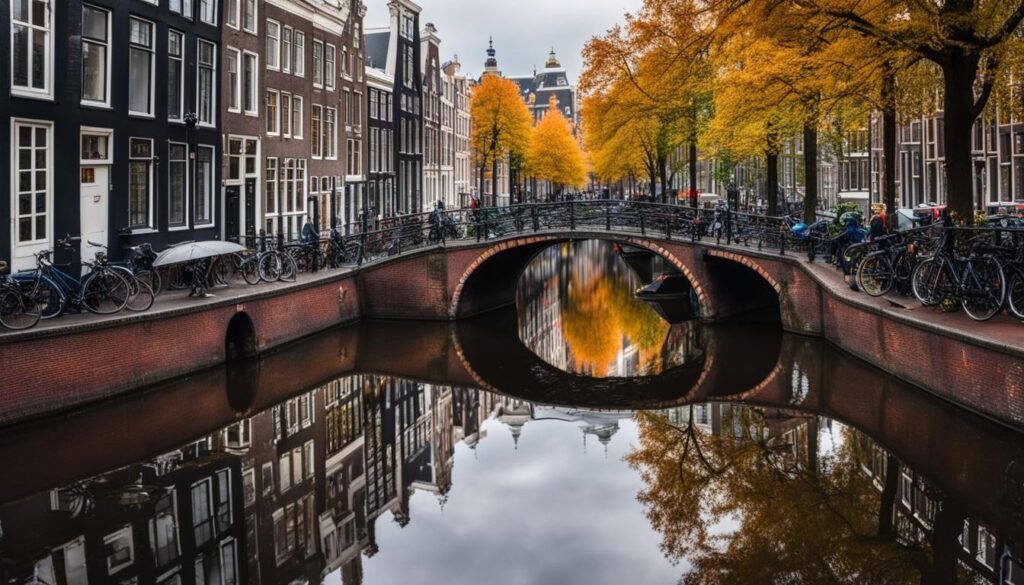
Amsterdam Weather Averages
| Month | High | Low | Rainfall |
|---|---|---|---|
| January | 6°C | 1°C | 63mm |
| February | 6°C | 0°C | 41mm |
| March | 9°C | 2°C | 50mm |
| April | 13°C | 5°C | 40mm |
| May | 17°C | 8°C | 49mm |
| June | 20°C | 11°C | 57mm |
| July | 22°C | 13°C | 80mm |
| August | 22°C | 13°C | 80mm |
| September | 19°C | 11°C | 72mm |
| October | 14°C | 8°C | 92mm |
| November | 9°C | 4°C | 84mm |
| December | 6°C | 2°C | 78mm |
Healthcare in Berlin
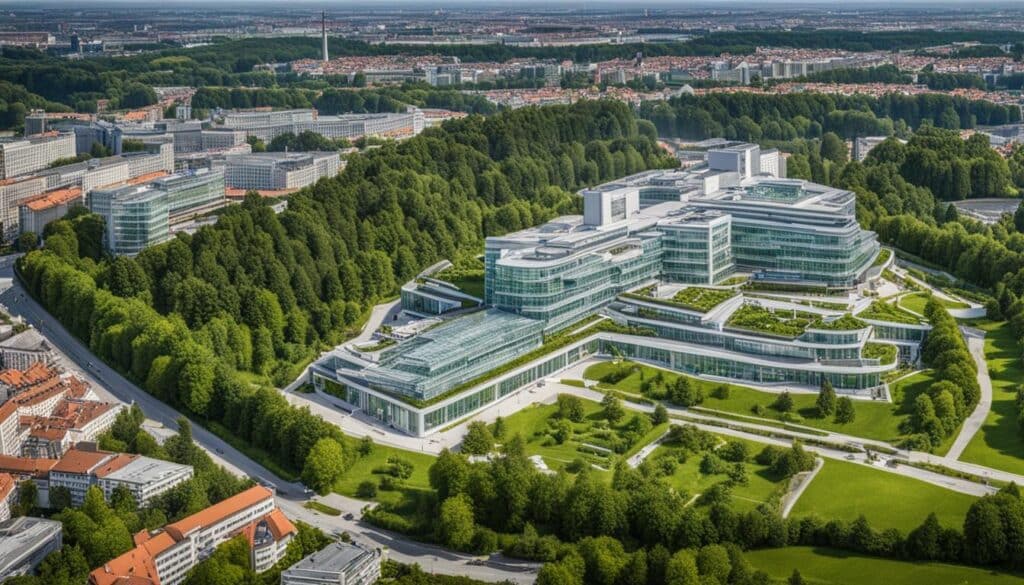
When it comes to healthcare, Berlin boasts a comprehensive and high-quality healthcare system as part of the larger German healthcare system. The German healthcare system is renowned for its emphasis on accessibility, affordability, and quality of care.
Residents of Berlin, like all residents in Germany, are required to have health insurance, ensuring that everyone has access to necessary medical services.
With a range of hospitals and medical facilities, Berlin provides a wide array of healthcare services to its residents. The city is home to well-respected hospitals, equipped with state-of-the-art technology and staffed by highly skilled healthcare professionals.
Whether you need routine check-ups, specialized treatments, or emergency care, Berlin’s healthcare system has you covered.
German health insurance provides coverage for a wide range of medical services, including doctor visits, hospital stays, prescription medications, and preventive care.
Depending on your income and employment status, you may be eligible for public health insurance, which offers comprehensive coverage at affordable rates. Private health insurance is also available for those who prefer additional coverage and personalized healthcare options.
Hospitals in Berlin
Here are some notable hospitals in Berlin:
- Charité – Universitätsmedizin Berlin
- Vivantes Netzwerk für Gesundheit
- Helios Kliniken Berlin
- DRK Kliniken Berlin
Health Insurance in Germany
Health insurance in Germany is compulsory for all residents, including those living in Berlin. There are two main types of health insurance available: public health insurance (gesetzliche Krankenversicherung) and private health insurance (private Krankenversicherung).
Public health insurance is provided by a selection of insurance funds known as Krankenkassen. It offers comprehensive coverage and is mandatory for individuals earning below a certain income threshold. The cost of public health insurance is income-based, with contributions shared between the employee and employer.
Private health insurance is available for individuals who exceed the income threshold for public health insurance or who prefer more extensive coverage and personalized healthcare options. Private insurance premiums are typically based on age, health status, and desired coverage.
| Public Health Insurance | Private Health Insurance |
|---|---|
| Comprehensive coverage | More extensive coverage options |
| Income-based contributions | Premiums based on age, health status, and desired coverage |
| Accessible to all residents | Criteria-based eligibility |
Healthcare in Amsterdam
Healthcare in Amsterdam is part of the Dutch healthcare system, which is known for its high quality and comprehensive coverage. Just like the rest of the Netherlands, health insurance is mandatory for all residents in Amsterdam. This ensures that everyone has access to the necessary medical care when they need it.
The Dutch healthcare system is based on a system of social health insurance, where everyone contributes to the cost of healthcare through their insurance premiums. This allows for a fair and equitable distribution of healthcare resources. It also ensures that healthcare services are accessible and affordable for all, regardless of their income or social status.
Amsterdam has a number of hospitals and medical facilities that provide a wide range of healthcare services to its residents. These facilities are equipped with modern technology and staffed by highly trained medical professionals. Whether you need emergency care, specialized treatment, or routine check-ups, you can expect to receive high-quality healthcare in Amsterdam.
| Amsterdam Hospitals | Location | Contact Information |
|---|---|---|
| Academic Medical Center Amsterdam | Meibergdreef 9, 1105 AZ Amsterdam | +31 20 566 9111 |
| OLVG Amsterdam | Oosterpark 9, 1091 AC Amsterdam | +31 20 599 9111 |
| VU University Medical Center | De Boelelaan 1117, 1081 HV Amsterdam | +31 20 444 4444 |
In conclusion, healthcare in Amsterdam is well-developed and provides comprehensive coverage for its residents. The Dutch healthcare system ensures that everyone has access to high-quality medical care, regardless of their income or social status. With its modern hospitals and skilled medical professionals, Amsterdam is equipped to meet the healthcare needs of its residents.
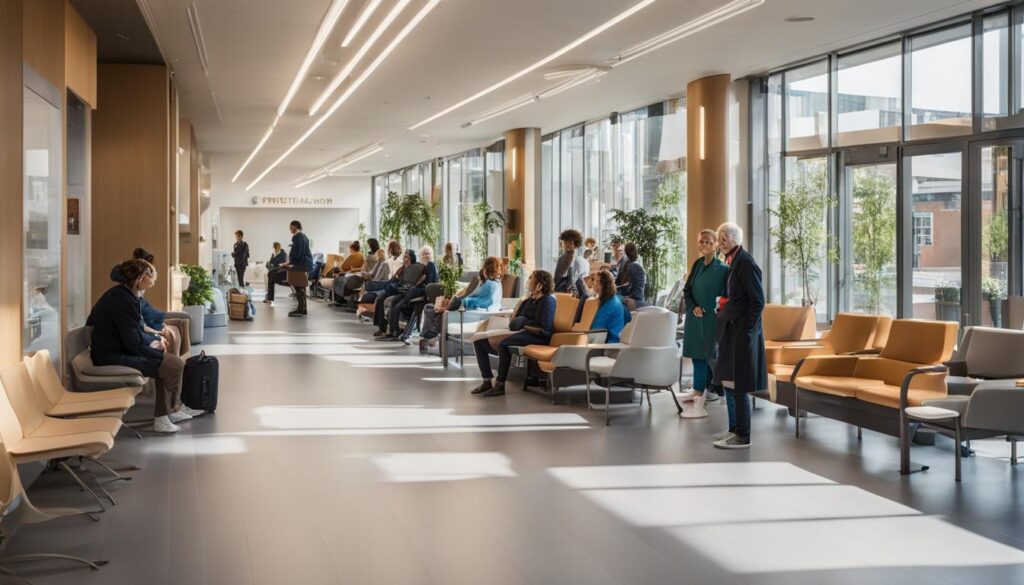
Culture and Cuisine in Berlin
Berlin is a city that boasts a vibrant cultural scene, making it a hub for art enthusiasts and music lovers from around the world. The city’s art scene is diverse and dynamic, with numerous galleries and museums showcasing a wide range of artistic expressions. From contemporary art installations to classic masterpieces, Berlin has something to offer for every art aficionado.
One of the most famous art venues in Berlin is the East Side Gallery, which features the longest remaining segment of the Berlin Wall adorned with colorful murals by artists from all over the globe. This open-air art gallery serves as a powerful symbol of unity and creativity in the city.
The music scene in Berlin is equally vibrant, with a thriving underground music scene and a rich history of electronic music. The city is home to legendary clubs such as Berghain and Watergate, where music lovers can dance the night away to the beats of renowned DJs. Berlin also hosts various music festivals throughout the year, attracting both local and international talent.
Cuisine in Berlin
Berlin’s culinary scene is as diverse as its cultural landscape. The city offers a mix of traditional German dishes and international cuisines, catering to every palate. From hearty classics like currywurst and schnitzel to fusion creations and plant-based options, Berlin’s food scene has something for everyone.
One cannot visit Berlin without trying a traditional German beer. The city has a long tradition of brewing, and there are numerous beer gardens and breweries to explore. Berlin is also known for its vibrant street food culture, with food markets and food trucks offering a wide array of culinary delights.
| Traditional German Dishes | International Cuisine |
|---|---|
| Schnitzel | Sushi |
| Bratwurst | Pizza |
| Sauerkraut | Tacos |
- Currywurst
- Döner kebab
- Berliner Pfannkuchen (Berliners)
“Berlin’s culinary scene reflects the city’s multicultural population and offers a taste of both traditional German cuisine and international flavors. Whether you’re exploring the city’s vibrant art scene or enjoying a night of live music, be sure to indulge in the diverse culinary delights that Berlin has to offer.”
Culture and Cuisine in Amsterdam
Amsterdam is a city that is brimming with culture in every corner. From its renowned art scene to its vibrant music scene, there is no shortage of artistic expression in this Dutch capital. The city is home to world-class museums and galleries, including the iconic Rijksmuseum and the Van Gogh Museum.
These cultural institutions showcase a wide range of artworks, from classic masterpieces to contemporary creations. Visitors can immerse themselves in the rich history and diverse artistic styles that Amsterdam has to offer.
One cannot talk about the culture of Amsterdam without mentioning its thriving music scene. The city has a strong tradition of producing talented musicians and hosting exciting music festivals.
From intimate jazz clubs to large concert halls, Amsterdam offers a variety of venues for music lovers to enjoy live performances. Whether you’re into classical music, jazz, electronic, or rock, there is something for everyone in this vibrant city.
When it comes to cuisine, Amsterdam has its own unique flavors to offer. Dutch food is hearty and delicious, with dishes that are known for their simplicity and rich flavors. Traditional Dutch cuisine includes favorites such as stroopwafels, herring, and bitterballen.
However, Amsterdam is also a melting pot of different cultures, and you’ll find a wide variety of international cuisines in the city. From trendy fusion restaurants to cozy neighborhood eateries, Amsterdam’s culinary scene has something to satisfy every palate.
To truly experience the culture and cuisine of Amsterdam, one must explore the city’s neighborhoods. Each neighborhood has its own distinct character and offers a unique blend of art, music, and culinary delights.
From the historic canals of Jordaan to the trendy streets of De Pijp, Amsterdam’s neighborhoods are a treasure trove of cultural experiences. Take a stroll through the picturesque streets, visit local galleries, and savor the flavors of Amsterdam’s diverse culinary scene.
| Amsterdam Art Scene | Amsterdam Music Scene | Amsterdam Cuisine |
|---|---|---|
| Renowned museums and galleries showcasing famous artworks | A thriving music scene with various music festivals throughout the year | Traditional Dutch dishes and a variety of international cuisines |
| Iconic institutions like the Rijksmuseum and Van Gogh Museum | Diverse range of musical genres, from classical to rock | Hearty and delicious dishes like stroopwafels and herring |
| Rich history and diverse artistic styles | Venues for live performances, from jazz clubs to concert halls | Fusion restaurants and cozy neighborhood eateries |
Conclusion
After comparing the cities of Berlin and Amsterdam, it’s clear that both have their own unique charm and attractions. Deciding between the two ultimately comes down to personal preferences and interests. If you’re a history enthusiast and enjoy exploring a city’s past, Berlin offers a rich and tumultuous history with iconic landmarks like the Berlin Wall.
On the other hand, if you’re drawn to the picturesque canals and renowned museums, Amsterdam is the perfect choice. The city’s vibrant art scene and lively atmosphere make it a cultural hub that delights visitors from around the world.
When it comes to navigating the cities, both Berlin and Amsterdam have efficient public transportation systems to help you get around. Berlin is known for its bike-friendly culture, while Amsterdam is famous for its extensive network of trams and buses.
In terms of cost of living, Berlin generally offers a lower cost of living compared to Amsterdam. However, Amsterdam’s higher cost of living is balanced by a higher minimum wage. It’s important to consider your budget and lifestyle when choosing between the two cities.
Ultimately, whether you prefer the dynamic energy of Berlin or the intimate beauty of Amsterdam, both cities have something special to offer. It’s all about finding the city that aligns with your interests and values. So, whether you’re a history buff, an art lover, or a food enthusiast, Berlin and Amsterdam are waiting to be explored.
FAQ
What are the main differences between Berlin and Amsterdam?
Berlin is the capital of Germany, while Amsterdam is the capital of the Netherlands. Berlin is known for its diverse population and rich history, including the Berlin Wall, while Amsterdam is famous for its picturesque canals and vibrant cultural scene.
How does the cost of living in Berlin compare to Amsterdam?
The cost of living in Berlin is generally lower compared to Amsterdam. However, housing prices have been increasing in Berlin in recent years. Both cities have affordable options for food and transportation, but Amsterdam tends to have a higher overall cost of living.
What is the transportation system like in Berlin and Amsterdam?
Both Berlin and Amsterdam have well-developed public transportation systems. Berlin has buses, trams, and a metro, as well as two major airports. Amsterdam also has trams, buses, and a metro, and its main airport, Schiphol, is one of the busiest in Europe.
What are the climates like in Berlin and Amsterdam?
Berlin has a temperate seasonal climate, with mild summers and cold winters. Amsterdam has a maritime climate, with mild summers and cool winters. Both cities experience rainfall throughout the year.
How is healthcare in Berlin and Amsterdam?
Both Berlin and Amsterdam have well-developed healthcare systems. Health insurance is mandatory for all residents in Germany and the Netherlands, including Berlin and Amsterdam. Both cities have a range of hospitals and medical facilities offering comprehensive healthcare services.
What are the cultural scenes like in Berlin and Amsterdam?
Berlin is known for its vibrant art scene, with numerous galleries and museums, as well as its diverse music venues. Amsterdam also has a rich cultural heritage, with world-class museums and a thriving music scene. Both cities offer a wide range of cultural experiences.
How do I choose between visiting Berlin or Amsterdam?
Choosing between Berlin and Amsterdam depends on your personal preferences and interests. Berlin offers a rich history and diverse cultural experiences, while Amsterdam charms with its picturesque canals and renowned museums. Consider what you value in a travel destination and choose accordingly.